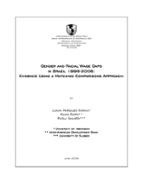Gender and Racial Wage Gaps in Brazil 1996-2006: Evidence Using a Matching Comparisons Approach
Date
May 2009
This paper explores the evolution of Brazilian wage gaps by gender and skin color over a decade (1996-2006), using the matching comparison methodology developed by Ñopo (2008). In Brazil, racial wage gaps are more pronounced than those found along the gender divide, although both noticeably decreased over the course of the last decade. The decomposition results show that differences in observable characteristics play a crucial role in explaining wage gaps. While in the case of racial wage gaps, observable human capital characteristics account for most of the observed wage gaps, the observed gender wage gaps have the opposite sign than what the differences in human capital characteristics would predict. In both cases the role of education is prominent.



